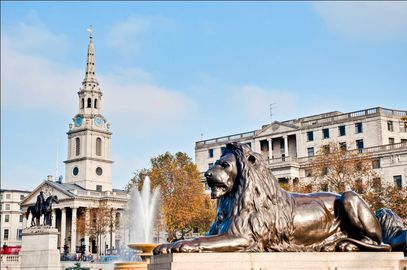

Although hidden behind its larger cousin the National Gallery, the National Portrait Gallery is not connected with the larger gallery. It's a small and intimate collection which Londoners themselves greatly love, and it's a 'special find' that many visitors miss. The gallery was founded in 1856 – amazingly for a budget of just £2000. It moved premises many times as it expanded over the years, and finally moved to this building in 1896 – the last project of architect Ewan Christie, who died shortly before the gallery opened to the public. The portraits are mostly of famous people, and include paintings, drawings, sketches, cartoons and photographs.
The large Church opposite the National Portrait Gallery, in St Martin's Place is called St Martins-in-the-Fields. So where are the fields? Long ago, this church would have been at a great distance from the Roman City of London. The earliest records of a church here are from the 13th century, when a church dedicated to St Martin of Tours, in France, stood here among fields. The basilica was torn down and rebuilt by King Henry VIII in the 16th century. Henry's reasons were strictly practical – the church was built so that plague victims could be buried locally, without being taken to the historic City for burial. Here at the church we start to see signs of Covent Garden's traditional associations with theatre.
The infamous actress Eleanor 'Nell' Gwynne was buried here in 17th century. Her story of gutter-to-greatness became a metaphor of life in 17th century London. She was the daughter of a former prostitute-turned-madam, who became an alcoholic, and her father had long since disappeared. Nell started as an 'orange-girl', selling oranges, programmes, and other items to playgoers at the Theatre Royal. The 'orange-girls' mostly used the opportunity to make liaisons with men, and Nell probably did so too. But she quickly became fascinated with the theatre, and began playing small parts. She was lucky: British theatres had only just reopened, after being closed down altogether for many years, by Puritan religious laws, and women were allowed to perform on the stage, instead of the women's parts being played by boys – as before. Nell's natural ability quickly won her major roles – although she had never learned to read. She had become the mistress of King Charles II. Charles was clearly deeply in love with her – when he died in 1685, his dying request to his chamberlain was 'let not poor Nelly starve'. She died from syphilis 3 years later. Her funeral here at St Martin's was attended by all of literary and theatrical London, and the sermon was preached – at her request – by the Archbishop of Canterbury. She was 37. She was once harangued by a group of men who saw her climbing into her carriage at Dover, when returning from Paris – they shouted 'Catholic Whore!' at her. 'Gentlemen, you are mistaken! I am a Protestant Whore!' she replied.
The modern church we see now replaced the one where Gwynne was buried, and was built in 1722 – the work of architect James Gibbs, although heavily influenced by Christopher Wren. The facade has a huge portico supported by six Corinthian columns. There was no Trafalgar Square when it was built – and in fact the beautiful view we enjoy now was then completely hidden behind slum buildings and warehouses, which were only demolished a century later.
In 1922 a priest named Dick Sheppard become the vicar of St Martin's, and changed its reputation forever. Sheppard was from a rich family, and had a Cambridge education, but his experiences as a military chaplain in the trenches of World War One changed his life, and he dedicated himself to serving only the poor. After work in the slums of the East End, he began to make St Martin's 'a church for all people'. He opened a free cafe for homeless people in the basement of the church, and began a program of help for poor and destitute people, which continues to this day. None of this has hindered the cultural side of the church's work, and it is home to one of London's finest orchestras – the Orchestra of St Martin's in the Fields. The orchestra made many recordings under its conductor, Neville Marriner – but it also continues to play free concerts for poor and underprivileged people. There is an excellent concert programme, with performances almost every day.